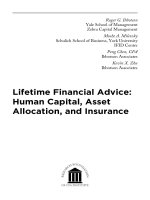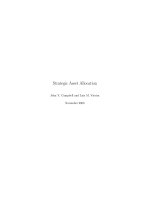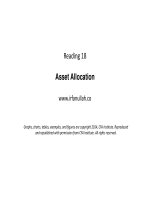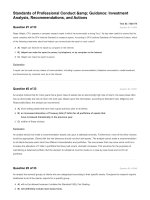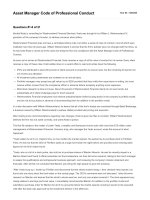Q a schweser self test 06 asset allocation question
Bạn đang xem bản rút gọn của tài liệu. Xem và tải ngay bản đầy đủ của tài liệu tại đây (173.19 KB, 7 trang )
Use the following information for Questions 1 through 6.
Tyler Robinson, CFA, a senior analyst at RNC Investments, is reviewing the investment policy
statements (IPS) of two new RNC clients. The first client, Bob Carlson, is a 45-year-old seasoned
investor who prefers to take a strategic approach to allocating his assets. The second client, Rick
Olsen, is a 22-year-old recent college graduate who believes in monitoring his portfolio on a daily
basis and capitalizing on perceived mispricings.
Carlson has just moved his account from Aggressive Investments (AI) to RNC because he was
uncomfortable with the 12% return AI was promising their clients. Carlson knew that this return
was only achievable with an increased level of risk-taking. Robinson interviews Carlson over the
phone and inquires about his spending rate and his risk aversion score on a scale of 1 to 10, with
10 indicating the lowest tolerance for risk. Carlson thinks that a 3% after-tax return should cover
his spending needs on an annual basis and believes that his risk aversion score would be 8 out
of 10.
Olsen has just opened up his first investments account through RNC. RNC services were
recommended to him by one of his college finance professors who has a son working at RNC.
Although he would like to manage his own investments, Olsen's new job requires him to work 60
hours a week leaving him little time to day trade for his own account. For this reason, Olsen has
handed investing responsibilities to RNC and consequently, Robinson. Robinson asks Olsen the
same two questions that he asked Carlson. Olsen thinks a 5% after-tax return is enough to cover
his spending needs and rates his risk aversion score at 2 out of 10.
Robinson begins to select a static asset allocation for each investor given the information he
gathered from both interviews. His first step entails specifying asset classes. Robinson believes
that the set of asset classes should provide a high level of diversification and they should have a
large percentage of liquid assets. However, he does not think that a majority of all possible
investable assets need to be included in a given portfolio analysis or that assets need to be
classified into more than one class. A drawback to Robinson's asset allocation approach is that
the number of estimates needed is overwhelming. Robinson evaluates the following asset
classes as possible investments for Carlson and Olsen:
Asset Class
U.S. Large-Cap
U.S. Small-Cap
U.S. Fixed Income
Real Estate
Expected
Return
8.5%
12%
5.5%
7.0%
Expected
Standard
Deviation
15%
20%
3%
12%
Robinson then creates four portfolios with the previous asset classes and calculates their
expected returns, standard deviations, and Sharpe ratios. The portfolios are as follows:
Portfolio
1
2
3
4
Exp.
Return
Exp.
Std.
Dev.
Sharpe
Ratio
6.50% 5.95% 0.756
7.25% 8.30% 0.633
8.00% 11.15% 0.538
8.75% 14.25% 0.474
Asset Class
Weights %
A
12
22
32
42
B
13
5
18
21
C
5
21
15
22
D
70
52
35
15
Robinson is anticipating a round of client presentations. He is preparing some discussion points
to use with his more sophisticated clients regarding issues associated with various approaches
and techniques related to strategic asset allocation. He has prepared the following points:
A. Identifying the risk-free asset is important for most clients because combinations of the riskfree asset and the market portfolio generally produce superior return to risk ratios.
Combinations of the risk-free and market normally dominate portfolios on the efficient frontier
that are made up of only risky assets and are more appropriate for most investors.
B. Neither asset only nor asset-liability management is necessarily superior. In the end it
depends on the client circumstances. For example, foundations and endowments normally
focus on asset only management. This is also true for most individuals. On the other hand,
banks are more suited to ALM approaches.
C. Both Black-Litterman and Resampled Efficient Frontier models are built from more basic
mean-variance analysis. The constrained Black-Litterman approach uses the underlying
mathematics of mean-variance but solves for expected returns by asset class. The
Resampled Efficient Frontier also uses the same underlying mathematics but solves for
weighted average combinations of assets classes for the various points on the efficient
frontier.
..........................................................................................................................................................
Question #1 of 13
Assuming Robinson recommended Portfolio 1 to Carlson and Portfolio 4 to Olsen, the utilityadjusted returns for both investors would be closest to:
A) 5.08% for Carlson and 6.72% for Olsen.
B) 6.72% for Olsen and 6.26% for Carlson.
C) 6.26% for Carlson and 8.61% for Olsen.
Question #2 of 13
Has Robinson appropriately specified the set of asset classes?
A) No, because a set of asset classes does not need to provide a high level of diversification.
B) No, because a set of asset classes does not need to contain a large percentage of liquid
assets.
C) No, because a set of asset classes should cover a majority of all possible investable assets.
Question #3 of 13
What approach to asset allocation is Robinson most likely using?
A) Resampled efficient frontier.
B) Mean-variance optimization.
C) Black-Litterman.
Question #4 of 13
Given the four portfolios that Robinson developed, the standard deviation of a portfolio that is
capable of achieving an expected return of 7.5% isclosest to:
A) 9.73%.
B) 9.51%.
C) 9.24%.
Question #5 of 13
Assuming a risk-free rate of 2.5% and no constraint against leverage, determine the weights that
should be invested in the risk-free asset and the tangency portfolio to achieve an expected return
of 7.5%.
A) The risk-free asset would be -20% and the tangency portfolio would be 120%.
B) The tangency portfolio would be 75% and the risk-free asset would be 25%.
C) The risk-free asset would be -25% and the tangency portfolio would be 125%.
Question #6 of 13
Which of Robinson's presentation points is least accurate?
A) Point A.
B) Point B.
C) Point C.
Use the following information for Questions 7 through 12.
Mary Freer is a portfolio manager for the Worldwide Investors Mutual Fund, a U.S. portfolio
manager based in New York. Kate McLaughlin, a recent college graduate, is her assistant.
At a lunch meeting, Freer discusses her strategies and concerns regarding the firm's equity and
currency exposure in its global portfolio. She states that the managers at the Worldwide
Investors Mutual Fund sometimes hedge their assets based on their expectations of
macroeconomic variables, such as interest rates or economic growth. Worldwide Investors
Mutual Fund portfolio managers that direct foreign investments have the additional concern of
currency risk, which is the sensitivity of an investment to changes in exchange rates, measured
in the investor's domestic currency. Freer is scheduled to give a presentation the next day that
outlines the basic hedging strategy used to offset currency risk and addresses the additional
aspects of currency risk, translation risk, and economic risk.
During her presentation the next day, Freer provides the following example. A U.S. portfolio
manager holds a portfolio of European stocks, currently worth € 300,000. The spot exchange rate
is currently $1.10/€ . The portfolio manager enters into a 3-month futures contract on the euro at
$1.15/€ . In one week, the value of the portfolio is € 320,000, the spot exchange rate is $1.20/€ ,
and the futures exchange rate is $1.23/€ . Freer assumes that the portfolio manager in this
example uses a simple hedge of the principal. She then asks the audience of junior analysts to
calculate the hedged and unhedged return in both dollars and euros.
Freer then discusses how the hedge could be improved so that it reduces currency risk. Instead
of a simple hedge of the principal, Freer states that the portfolio manager could have used the
minimum-variance hedge ratio, where the ratio is derived by regressing the unhedged return on
the foreign stock in dollar terms against the return on the futures contract. She states that this is
necessary because there is a relationship between an exporter's currency value and its exports,
where a currency depreciation is accompanied by a decrease in sales.
The next day, McLaughlin mentions that basis risk can make hedging currency risk difficult. She
states that the basis risk is unpredictable in the short run. For example, if the interest rate for a
country increases, the forward exchange rate of that currency will decrease, and this will
decrease the holding period return for anyone who sold the currency forward. But in the long run,
basis risk can be minimized by matching the contract expiration of a forward contract to the
desired hedging period.
Worldwide Investors Mutual Fund has a position in Swiss stocks that Freer would like to hedge.
The value of the position is CHF 4,000,000. Because Freer is certain the CHF will decline, he is
considering hedging the stocks with a short position in futures contracts. He is also considering
the use of option contracts as an alternative. Each option contract is for CHF 62,500.
Discussing currency risk management in general, Freer tells McLaughlin that it has been the
policy of the Worldwide Investors Mutual Fund to use a strategic hedge ratio approach. She
states that this provides the manager total discretion for hedging currency risk within the
guidelines of the investor's investment policy statement. She believes that this approach is
optimal.
..........................................................................................................................................................
Question #7 of 13
In Freer's European stock example, the unhedged return in dollar terms is closest to:
A) 8.4%.
B) 16.4%.
C) 6.7%.
Question #8 of 13
In Freer's European stock example, the hedged return in dollar terms is closest to:
A) 16.4%.
B) 6.7%.
C) 9.1%.
Question #9 of 13
Regarding Freer's statement concerning the minimum-variance hedge ratio, Freer is:
A) correct.
B) incorrect because a currency depreciation would be accompanied by an increase in sales.
C) incorrect because a currency depreciation would be accompanied by an increase in sales
and because the ratio is derived by regressing the hedged return on the foreign stock in
dollar terms against the return on the futures contract.terms against the return on the
currency futures contract.
Question #10 of 13
Regarding McLaughlin's statements concerning basis risk, McLaughlin is:
A) correct on both.
B) incorrect regarding the short run.
C) incorrect regarding the long run.
Question #11 of 13
Given Freer's views for the CHF, the best strategy for Worldwide Investors Mutual Fund to use to
hedge the currency risk of the Swiss stock position using options is:
A) buy 64 put option contracts.
B) buy 160 call option contracts.
C) buy 64 put option contracts and sell 64 call option contracts.
Question #12 of 13
Regarding Freer's statement concerning the strategic hedge ratio approach, Freer is:
A) incorrect because under a strategic hedge ratio approach, the currency risk is managed
separate from the rest of the portfolio.
B) incorrect because under a strategic hedge ratio approach, the currency risk is managed
separate from the rest of the portfolio rate and because she is describing a currency overlay
approach.
C) correct.
Question #13 of 13
Many investors believe that small-cap stocks outperform large-cap in the long run. Others argue
that when returns are viewed on a risk-adjusted basis the differential is smaller or even
immaterial. If small-cap stocks do outperform, discuss how the relative turnover and transaction
costs of an equal-weighted versus market cap weighted indexes would be affected.
Answer / Comment:
